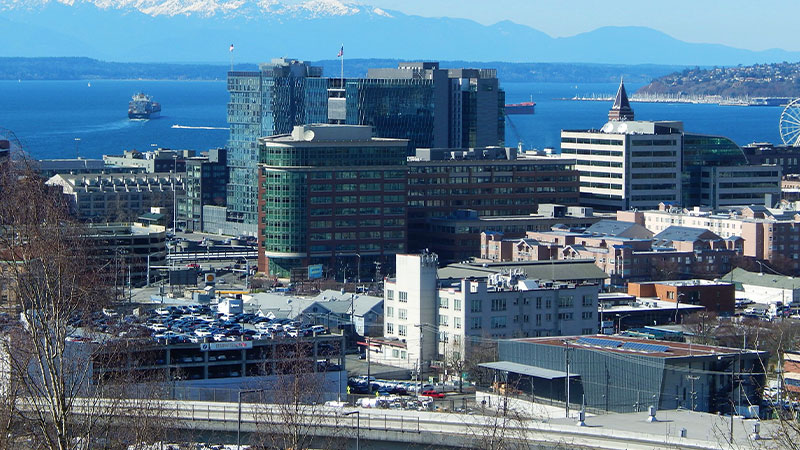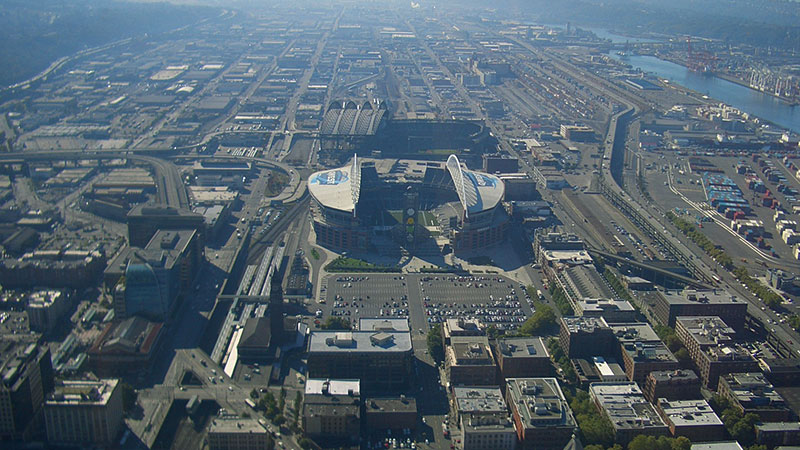If you’ve ever found yourself wandering around Seattle, you might have encountered a neighborhood with a unique name – SODO.
At first glance, it’s easy to assume this is just another trendy acronym cooked up by urban developers. But what does SODO mean?
Originally, SODO was short for “South of the Dome,” referring to the Kingdome stadium that once stood tall in this area.
However, after its demolition in 2000, the interpretation of SODO evolved. Today, locals understand it as “South of Downtown”.
This change reflects the physical changes in Seattle’s landscape and highlights how deeply rooted and flexible local lingo can be.
So there you have it! SODO isn’t just a clever moniker or a random assortment of letters on a map. It’s an ode to Seattle’s past and present, embodying its historical landmarks and current geographical reference points.
Whether you’re a visitor trying to navigate your way around or simply curious about local culture, understanding what SODO means will certainly add depth to your Seattle experience.
Unraveling the Mystery: What Does SoDo Mean?
Let’s dive into the heart of Seattle, a vibrant city known for its coffee, music, and tech scene. But there’s an area that often puzzles visitors – it’s called “SoDo.” You might be wondering what this term means. Well, I’m here to unravel this for you.
Originally, SoDo was short for “South of Dome,” referring to the now-demolished Kingdome stadium. The Kingdome was a multi-purpose concrete dome stadium in Seattle’s Industrial District. It opened in 1976 and served as home turf for several sports teams until it was imploded in 2000.
But let’s rewind a bit. The name ‘SoDo’ didn’t exactly roll off the tongue when it initially came into use during the late 90s – folks weren’t too keen on this abbreviation.
There were debates about whether it should be used since it seemed like a blatant copy of New York’s famous ‘SoHo’ district tag.
Regardless of these early misgivings, ‘SoDo’ stuck around. After the Kingdome was brought down, people started interpreting SoDo as ‘South of Downtown.’ That made sense, considering its geographical location – just south of downtown Seattle.
Nowadays, when you roam around SoDo, you’ll find yourself amidst warehouses and industrial spaces mixed with art galleries, breweries, and trendy restaurants.
Despite transforming from an industrial hub to an increasingly vibrant neighborhood, many still wonder what ‘SoDo’ stands for every time they pass by one of its eclectic establishments or colorful murals.
Here are some key takeaways about SoDo:
- Originally meant ‘South of Dome’, referring to the former Kingdome Stadium.
- Debates occurred regarding its usage due to similarities with New York’s ‘SoHo’ tag.
- After the demolition of the Kingdome, SoDo took on the meaning ‘South of Downtown.’
- Today, SoDo is a mix of industrial spaces and cultural hotspots.
So there you have it. The mystery of what SoDo means is no longer a puzzling question. It’s a testament to Seattle’s evolving landscape, holding onto its past while embracing new developments. This blend of old and new makes SoDo an intriguing piece in Seattle’s dynamic puzzle.
Digging Deeper: The History of Sodo in Seattle
I’m sure you’ve heard the term “Sodo” tossed around quite a bit if you’re familiar with Seattle. But what does it mean?
Sodo, an acronym for South of Downtown, refers to the neighborhood just south of downtown Seattle. Its history is as rich and diverse as the city itself.
In its early days, back in the 19th century, Sodo was primarily an industrial area. It served as a home base for many businesses moving goods in and out of Seattle. Warehouses and railroad tracks dominated the neighborhood’s landscape.
But over time, things started changing. In 1977, King County built the Kingdome sports stadium right smack dab in the heart of Sodo.
This shifted the neighborhood’s identity significantly – from a purely industrial to a location associated with fun and entertainment.
Now fast forward to today – after several transformations (like when they tore down Kingdome), Sodo has evolved into a vibrant neighborhood that houses not only industries but also trendy lofts, creative workspaces, breweries, and even sports stadiums like CenturyLink Field, and T-Mobile Park.
Here’s an interesting fact: Did you know that Starbucks’ world headquarters is located here too?
The metamorphosis of Sodo over time truly reflects how neighborhoods can evolve with shifting economic trends while still maintaining their core character.
So next time you hear “Sodo,” remember it’s more than just a catchy name. It’s a testament to Seattle’s dynamic urban growth and development!
Not Just a Name: How Sodo Influences Seattle’s Identity
Seattle wouldn’t be the same without Sodo. It’s more than just a district; it’s an essential part of the city’s identity and history.
Originally named for its location, “South of the (King) Dome,” even after the demolition of the Kingdome, this area has remained an influential piece of Seattle’s cultural fabric.
Here are some of the key ways in which Sodo influences Seattle’s identity
Historical Significance
Sodo’s origins date back to its establishment as an industrial hub south of the Kingdom. While the dome may have been demolished, Sodo retains its historical significance, serving as a reminder of Seattle’s industrial past.
This heritage contributes to the city’s identity as a place shaped by blue-collar labor and gritty determination.
Cultural Hub
The presence of iconic landmarks like the Starbucks headquarters, CenturyLink Field, and T-Mobile Park solidifies Sodo’s status as a cultural hub within Seattle.
These institutions attract visitors and foster a sense of community pride among locals, reinforcing Seattle’s reputation as a city of innovation and sportsmanship.
Artistic Expression
Sodo’s transformation into an eclectic blend of old industrial charm and contemporary art spaces speaks to Seattle’s creative spirit.
The SODO Track, adorned with murals from artists worldwide, showcases the city’s commitment to artistic expression and urban revitalization.
This infusion of creativity adds depth to Seattle’s cultural identity, positioning it as a place where art thrives amidst urban landscapes.
Economic Engine
The proximity of Sodo to the Port of Seattle, one of America’s busiest ports, underscores its importance as an economic engine for the region.
The port’s influence on trade relations and job opportunities directly impacts Seattle’s economy, shaping its identity as a city deeply intertwined with global commerce and maritime industries.
Uniting Community
Beyond its economic and cultural significance, Sodo is a unifying force within the Seattle community.
Whether through shared experiences at sports events or appreciation for local art, Sodo brings people together, fostering connections that strengthen the city’s identity as a diverse and vibrant metropolis.
Exploring Landmarks and Highlights of Sodo, Seattle

I’ve got to admit, there’s something extraordinary about Sodo, Seattle. It’s a neighborhood that’s chock-full of character and charm.
From its rich industrial history to the thriving art scene that’s emerged in recent years, it’s no wonder this district is a favorite among locals and tourists alike.
Let me take you on a quick tour around some of the best spots in the area. First, we can’t discuss Sodo without mentioning its sports hub – CenturyLink Field and T-Mobile Park.
Whether you are a football fanatic or a baseball buff, these stadiums will surely pump your adrenaline.
Next up is Starbucks Reserve Roastery & Tasting Room. As one of only six such locations worldwide, it offers an immersive coffee experience. You’ll also find plenty of local breweries scattered throughout the district – perfect for those who enjoy craft beers.
Art enthusiasts won’t be disappointed either! The neighborhood boasts numerous art galleries and studios showcasing everything from contemporary pieces to vintage treasures.
- CenturyLink Field
- T-Mobile Park
- Starbucks Reserve Roastery & Tasting Room
Finally, if you’re into shopping, Sodo has covered you, too. With its eclectic mix of retail outlets – from chic boutiques to quirky thrift stores – there’s something for every shopper here.
So whether you’re visiting for a day or planning an extended stay, I guarantee there’s more than enough in Sodo to keep you entertained!
FAQs
What is the significance of Sodo’s name?
Sodo, short for “South of Downtown,” originally referred to the area south of the Kingdome in Seattle. The name reflects its geographical location and historical ties to the demolished stadium. Over time, Sodo has evolved into a diverse neighborhood with cultural, economic, and industrial significance.
How has Sodo contributed to Seattle’s coffee culture?
While often associated with sports stadiums and industry, Sodo is also home to the Starbucks headquarters. As a global coffee giant, Starbucks has played a significant role in shaping Seattle’s reputation as a hub for coffee culture. The presence of Starbucks in Sodo highlights the neighborhood’s diverse contributions to Seattle’s identity.
What role does Sodo play in Seattle’s transportation network? Sodo’s location near major transportation arteries, including highways, railways, and the Port of Seattle, makes it a crucial hub for transportation and logistics.
The neighborhood’s industrial roots and proximity to critical transportation infrastructure have shaped its identity and economic significance within the city.
4. How does Sodo support local artists and creative endeavors?
Sodo is a center for industry and sports and a vibrant artistic community. The SODO Track, a 2-mile-long stretch adorned with murals from artists worldwide, is a testament to the neighborhood’s support for creative expression.
Sodo contributes to Seattle’s artistic landscape and cultural identity through initiatives like the SODO Track.
Conclusion
Sodo in Seattle encapsulates far more than its geographical coordinates. It embodies a rich tapestry of history, culture, industry, and community.
From its industrial roots south of the Kingdome to its present-day role as a cultural and economic hub, Sodo holds a unique place in Seattle’s identity.
Through landmarks like the Starbucks headquarters and sports stadiums like CenturyLink Field and T-Mobile Park, Sodo shapes the city’s cultural landscape.
Additionally, its support for artistic expression, exemplified by the SODO Track, highlights the neighborhood’s dynamic spirit.
Sodo’s significance transcends its name, offering a glimpse into the heart of Seattle’s past, present, and future aspirations.







